Impact of Challenges on Leadership: Enhancing Quality Strategies
VerifiedAdded on 2023/06/07
|14
|4046
|433
Essay
AI Summary
This essay explores the multifaceted challenges impacting leadership within modern organizations, focusing on both external and internal factors. External challenges include technological disruptions, where leaders must adapt to social media's influence and balance traditional control with open participation. Internal challenges encompass managing expectations, fostering strong relationships, and resolving conflicts effectively. The essay also addresses the difficulties in building brand loyalty amidst intense competition and the importance of transmitting organizational values. Ultimately, the essay emphasizes the need for leaders to develop practical solutions, manage conflicts constructively, and create a supportive environment where employees can contribute to the organization's success. Desklib provides access to this essay along with a wealth of other solved assignments and study resources for students.
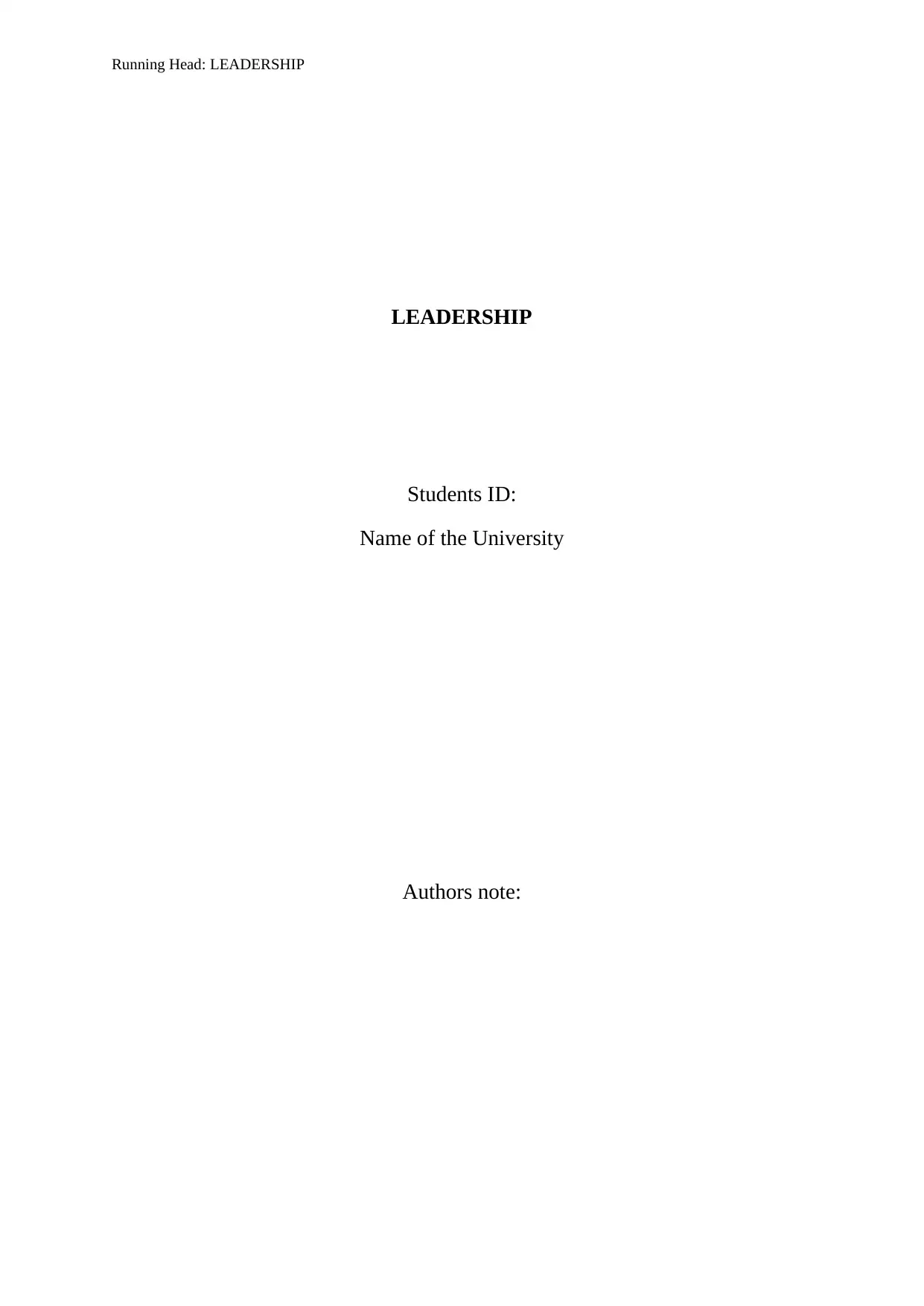
Running Head: LEADERSHIP
LEADERSHIP
Students ID:
Name of the University
Authors note:
LEADERSHIP
Students ID:
Name of the University
Authors note:
Paraphrase This Document
Need a fresh take? Get an instant paraphrase of this document with our AI Paraphraser
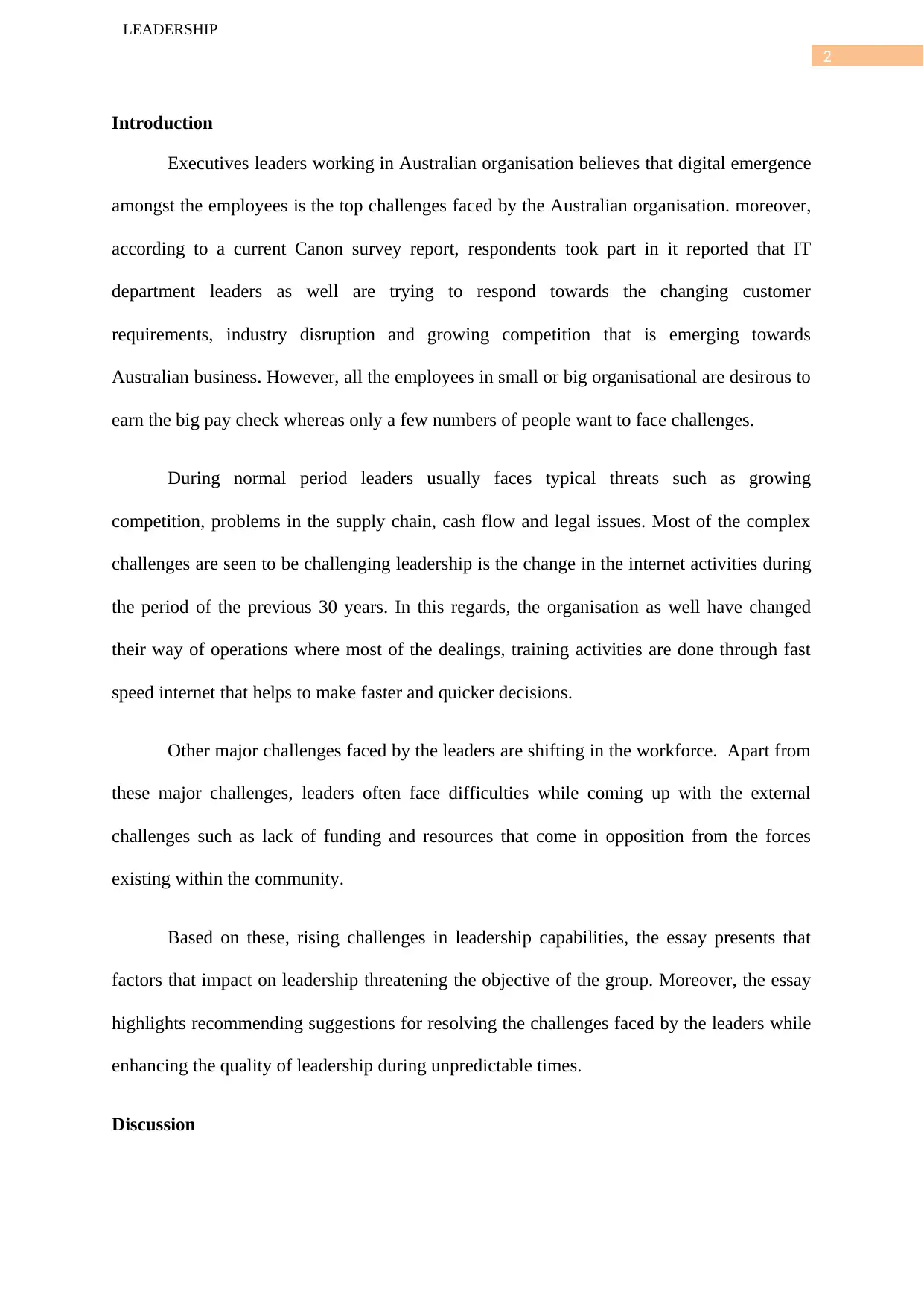
2
LEADERSHIP
Introduction
Executives leaders working in Australian organisation believes that digital emergence
amongst the employees is the top challenges faced by the Australian organisation. moreover,
according to a current Canon survey report, respondents took part in it reported that IT
department leaders as well are trying to respond towards the changing customer
requirements, industry disruption and growing competition that is emerging towards
Australian business. However, all the employees in small or big organisational are desirous to
earn the big pay check whereas only a few numbers of people want to face challenges.
During normal period leaders usually faces typical threats such as growing
competition, problems in the supply chain, cash flow and legal issues. Most of the complex
challenges are seen to be challenging leadership is the change in the internet activities during
the period of the previous 30 years. In this regards, the organisation as well have changed
their way of operations where most of the dealings, training activities are done through fast
speed internet that helps to make faster and quicker decisions.
Other major challenges faced by the leaders are shifting in the workforce. Apart from
these major challenges, leaders often face difficulties while coming up with the external
challenges such as lack of funding and resources that come in opposition from the forces
existing within the community.
Based on these, rising challenges in leadership capabilities, the essay presents that
factors that impact on leadership threatening the objective of the group. Moreover, the essay
highlights recommending suggestions for resolving the challenges faced by the leaders while
enhancing the quality of leadership during unpredictable times.
Discussion
LEADERSHIP
Introduction
Executives leaders working in Australian organisation believes that digital emergence
amongst the employees is the top challenges faced by the Australian organisation. moreover,
according to a current Canon survey report, respondents took part in it reported that IT
department leaders as well are trying to respond towards the changing customer
requirements, industry disruption and growing competition that is emerging towards
Australian business. However, all the employees in small or big organisational are desirous to
earn the big pay check whereas only a few numbers of people want to face challenges.
During normal period leaders usually faces typical threats such as growing
competition, problems in the supply chain, cash flow and legal issues. Most of the complex
challenges are seen to be challenging leadership is the change in the internet activities during
the period of the previous 30 years. In this regards, the organisation as well have changed
their way of operations where most of the dealings, training activities are done through fast
speed internet that helps to make faster and quicker decisions.
Other major challenges faced by the leaders are shifting in the workforce. Apart from
these major challenges, leaders often face difficulties while coming up with the external
challenges such as lack of funding and resources that come in opposition from the forces
existing within the community.
Based on these, rising challenges in leadership capabilities, the essay presents that
factors that impact on leadership threatening the objective of the group. Moreover, the essay
highlights recommending suggestions for resolving the challenges faced by the leaders while
enhancing the quality of leadership during unpredictable times.
Discussion
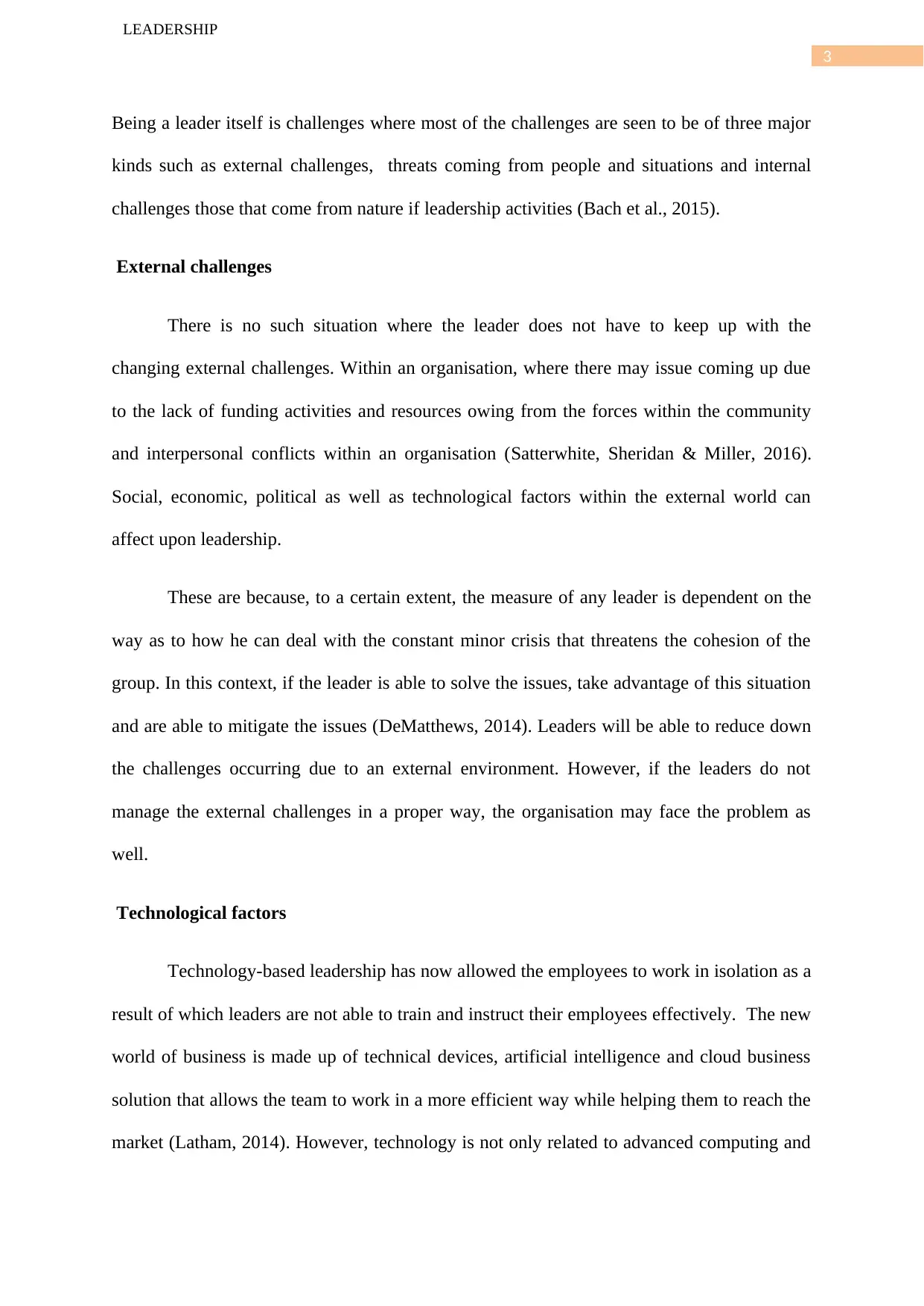
3
LEADERSHIP
Being a leader itself is challenges where most of the challenges are seen to be of three major
kinds such as external challenges, threats coming from people and situations and internal
challenges those that come from nature if leadership activities (Bach et al., 2015).
External challenges
There is no such situation where the leader does not have to keep up with the
changing external challenges. Within an organisation, where there may issue coming up due
to the lack of funding activities and resources owing from the forces within the community
and interpersonal conflicts within an organisation (Satterwhite, Sheridan & Miller, 2016).
Social, economic, political as well as technological factors within the external world can
affect upon leadership.
These are because, to a certain extent, the measure of any leader is dependent on the
way as to how he can deal with the constant minor crisis that threatens the cohesion of the
group. In this context, if the leader is able to solve the issues, take advantage of this situation
and are able to mitigate the issues (DeMatthews, 2014). Leaders will be able to reduce down
the challenges occurring due to an external environment. However, if the leaders do not
manage the external challenges in a proper way, the organisation may face the problem as
well.
Technological factors
Technology-based leadership has now allowed the employees to work in isolation as a
result of which leaders are not able to train and instruct their employees effectively. The new
world of business is made up of technical devices, artificial intelligence and cloud business
solution that allows the team to work in a more efficient way while helping them to reach the
market (Latham, 2014). However, technology is not only related to advanced computing and
LEADERSHIP
Being a leader itself is challenges where most of the challenges are seen to be of three major
kinds such as external challenges, threats coming from people and situations and internal
challenges those that come from nature if leadership activities (Bach et al., 2015).
External challenges
There is no such situation where the leader does not have to keep up with the
changing external challenges. Within an organisation, where there may issue coming up due
to the lack of funding activities and resources owing from the forces within the community
and interpersonal conflicts within an organisation (Satterwhite, Sheridan & Miller, 2016).
Social, economic, political as well as technological factors within the external world can
affect upon leadership.
These are because, to a certain extent, the measure of any leader is dependent on the
way as to how he can deal with the constant minor crisis that threatens the cohesion of the
group. In this context, if the leader is able to solve the issues, take advantage of this situation
and are able to mitigate the issues (DeMatthews, 2014). Leaders will be able to reduce down
the challenges occurring due to an external environment. However, if the leaders do not
manage the external challenges in a proper way, the organisation may face the problem as
well.
Technological factors
Technology-based leadership has now allowed the employees to work in isolation as a
result of which leaders are not able to train and instruct their employees effectively. The new
world of business is made up of technical devices, artificial intelligence and cloud business
solution that allows the team to work in a more efficient way while helping them to reach the
market (Latham, 2014). However, technology is not only related to advanced computing and
⊘ This is a preview!⊘
Do you want full access?
Subscribe today to unlock all pages.

Trusted by 1+ million students worldwide
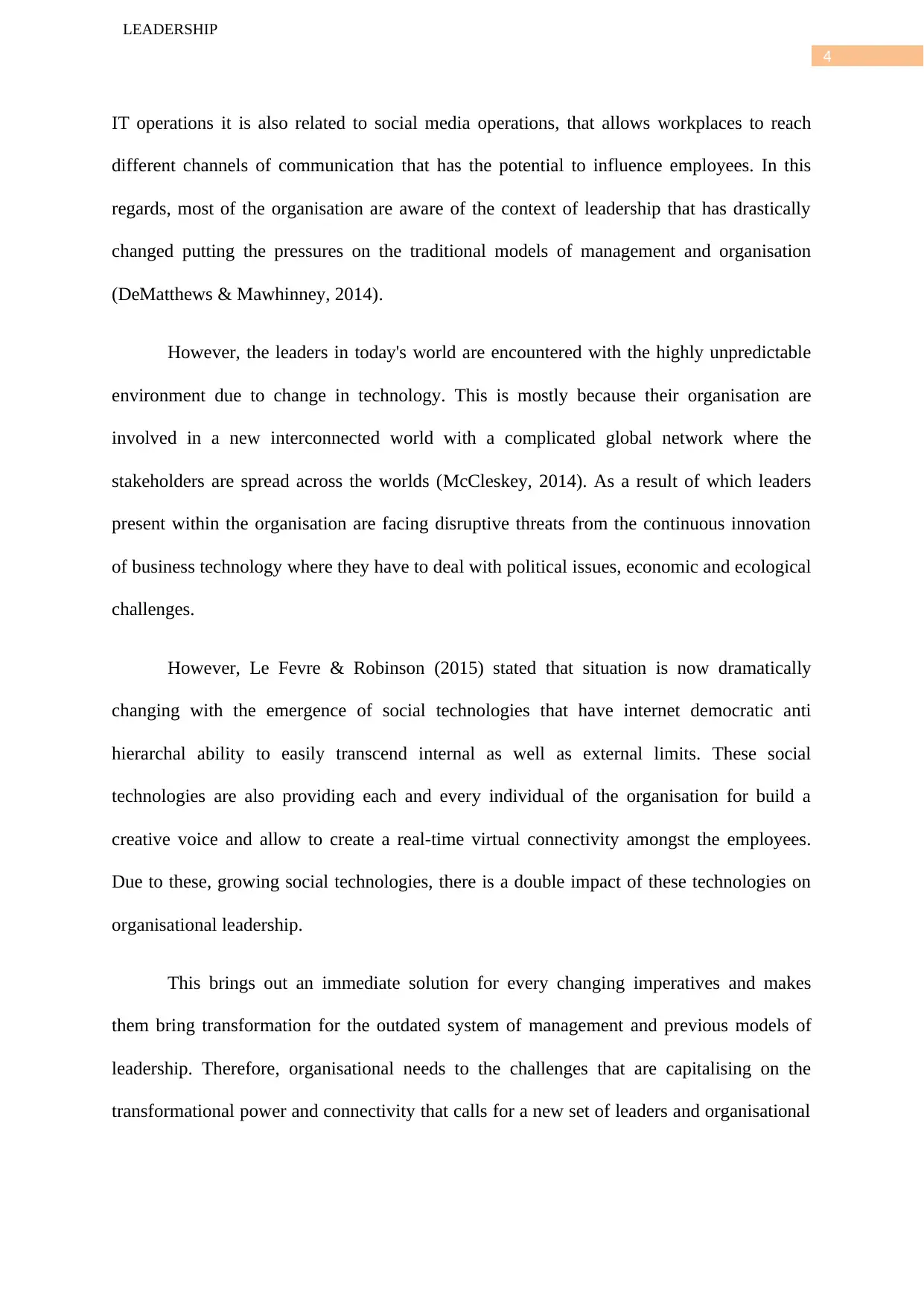
4
LEADERSHIP
IT operations it is also related to social media operations, that allows workplaces to reach
different channels of communication that has the potential to influence employees. In this
regards, most of the organisation are aware of the context of leadership that has drastically
changed putting the pressures on the traditional models of management and organisation
(DeMatthews & Mawhinney, 2014).
However, the leaders in today's world are encountered with the highly unpredictable
environment due to change in technology. This is mostly because their organisation are
involved in a new interconnected world with a complicated global network where the
stakeholders are spread across the worlds (McCleskey, 2014). As a result of which leaders
present within the organisation are facing disruptive threats from the continuous innovation
of business technology where they have to deal with political issues, economic and ecological
challenges.
However, Le Fevre & Robinson (2015) stated that situation is now dramatically
changing with the emergence of social technologies that have internet democratic anti
hierarchal ability to easily transcend internal as well as external limits. These social
technologies are also providing each and every individual of the organisation for build a
creative voice and allow to create a real-time virtual connectivity amongst the employees.
Due to these, growing social technologies, there is a double impact of these technologies on
organisational leadership.
This brings out an immediate solution for every changing imperatives and makes
them bring transformation for the outdated system of management and previous models of
leadership. Therefore, organisational needs to the challenges that are capitalising on the
transformational power and connectivity that calls for a new set of leaders and organisational
LEADERSHIP
IT operations it is also related to social media operations, that allows workplaces to reach
different channels of communication that has the potential to influence employees. In this
regards, most of the organisation are aware of the context of leadership that has drastically
changed putting the pressures on the traditional models of management and organisation
(DeMatthews & Mawhinney, 2014).
However, the leaders in today's world are encountered with the highly unpredictable
environment due to change in technology. This is mostly because their organisation are
involved in a new interconnected world with a complicated global network where the
stakeholders are spread across the worlds (McCleskey, 2014). As a result of which leaders
present within the organisation are facing disruptive threats from the continuous innovation
of business technology where they have to deal with political issues, economic and ecological
challenges.
However, Le Fevre & Robinson (2015) stated that situation is now dramatically
changing with the emergence of social technologies that have internet democratic anti
hierarchal ability to easily transcend internal as well as external limits. These social
technologies are also providing each and every individual of the organisation for build a
creative voice and allow to create a real-time virtual connectivity amongst the employees.
Due to these, growing social technologies, there is a double impact of these technologies on
organisational leadership.
This brings out an immediate solution for every changing imperatives and makes
them bring transformation for the outdated system of management and previous models of
leadership. Therefore, organisational needs to the challenges that are capitalising on the
transformational power and connectivity that calls for a new set of leaders and organisational
Paraphrase This Document
Need a fresh take? Get an instant paraphrase of this document with our AI Paraphraser
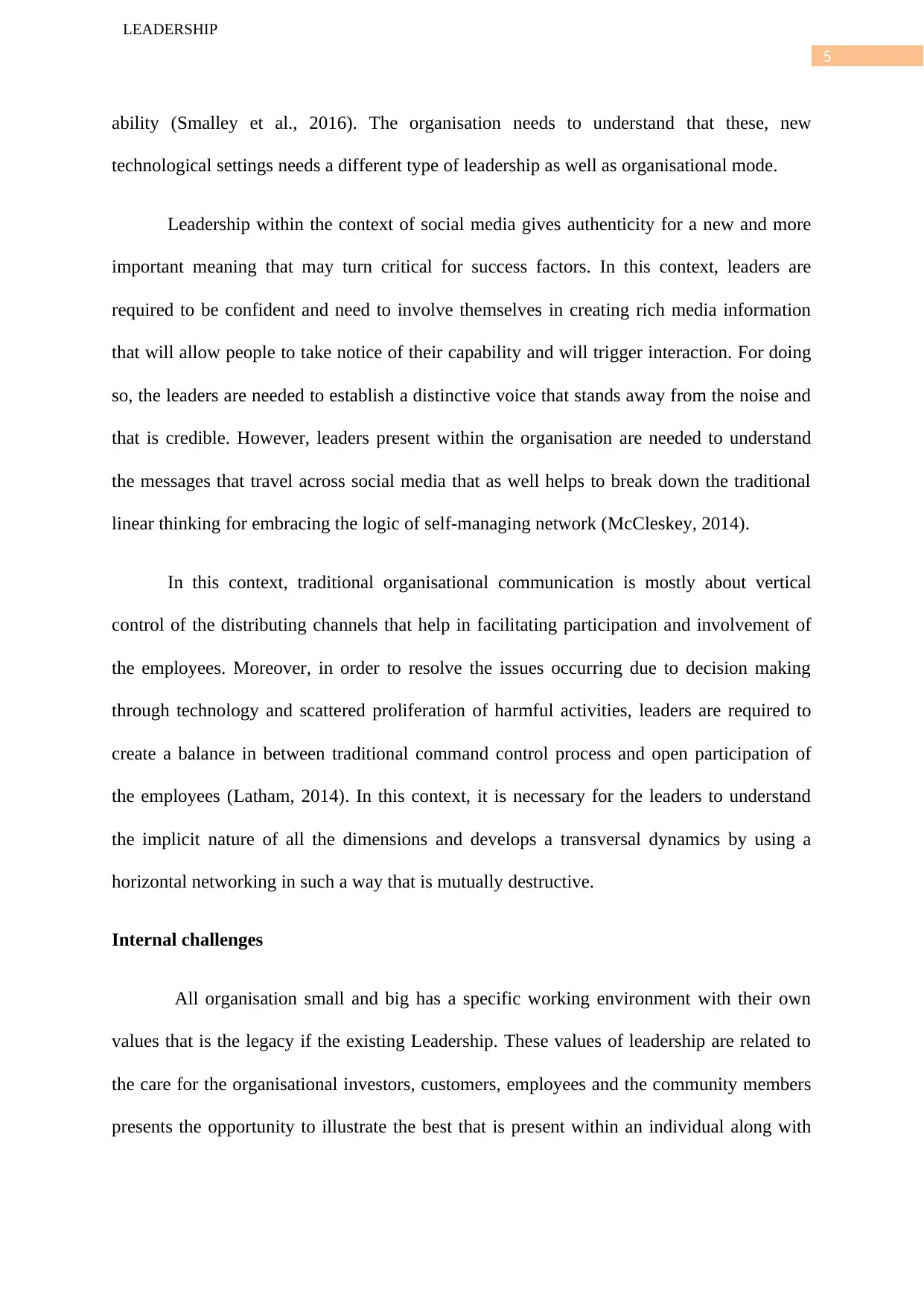
5
LEADERSHIP
ability (Smalley et al., 2016). The organisation needs to understand that these, new
technological settings needs a different type of leadership as well as organisational mode.
Leadership within the context of social media gives authenticity for a new and more
important meaning that may turn critical for success factors. In this context, leaders are
required to be confident and need to involve themselves in creating rich media information
that will allow people to take notice of their capability and will trigger interaction. For doing
so, the leaders are needed to establish a distinctive voice that stands away from the noise and
that is credible. However, leaders present within the organisation are needed to understand
the messages that travel across social media that as well helps to break down the traditional
linear thinking for embracing the logic of self-managing network (McCleskey, 2014).
In this context, traditional organisational communication is mostly about vertical
control of the distributing channels that help in facilitating participation and involvement of
the employees. Moreover, in order to resolve the issues occurring due to decision making
through technology and scattered proliferation of harmful activities, leaders are required to
create a balance in between traditional command control process and open participation of
the employees (Latham, 2014). In this context, it is necessary for the leaders to understand
the implicit nature of all the dimensions and develops a transversal dynamics by using a
horizontal networking in such a way that is mutually destructive.
Internal challenges
All organisation small and big has a specific working environment with their own
values that is the legacy if the existing Leadership. These values of leadership are related to
the care for the organisational investors, customers, employees and the community members
presents the opportunity to illustrate the best that is present within an individual along with
LEADERSHIP
ability (Smalley et al., 2016). The organisation needs to understand that these, new
technological settings needs a different type of leadership as well as organisational mode.
Leadership within the context of social media gives authenticity for a new and more
important meaning that may turn critical for success factors. In this context, leaders are
required to be confident and need to involve themselves in creating rich media information
that will allow people to take notice of their capability and will trigger interaction. For doing
so, the leaders are needed to establish a distinctive voice that stands away from the noise and
that is credible. However, leaders present within the organisation are needed to understand
the messages that travel across social media that as well helps to break down the traditional
linear thinking for embracing the logic of self-managing network (McCleskey, 2014).
In this context, traditional organisational communication is mostly about vertical
control of the distributing channels that help in facilitating participation and involvement of
the employees. Moreover, in order to resolve the issues occurring due to decision making
through technology and scattered proliferation of harmful activities, leaders are required to
create a balance in between traditional command control process and open participation of
the employees (Latham, 2014). In this context, it is necessary for the leaders to understand
the implicit nature of all the dimensions and develops a transversal dynamics by using a
horizontal networking in such a way that is mutually destructive.
Internal challenges
All organisation small and big has a specific working environment with their own
values that is the legacy if the existing Leadership. These values of leadership are related to
the care for the organisational investors, customers, employees and the community members
presents the opportunity to illustrate the best that is present within an individual along with
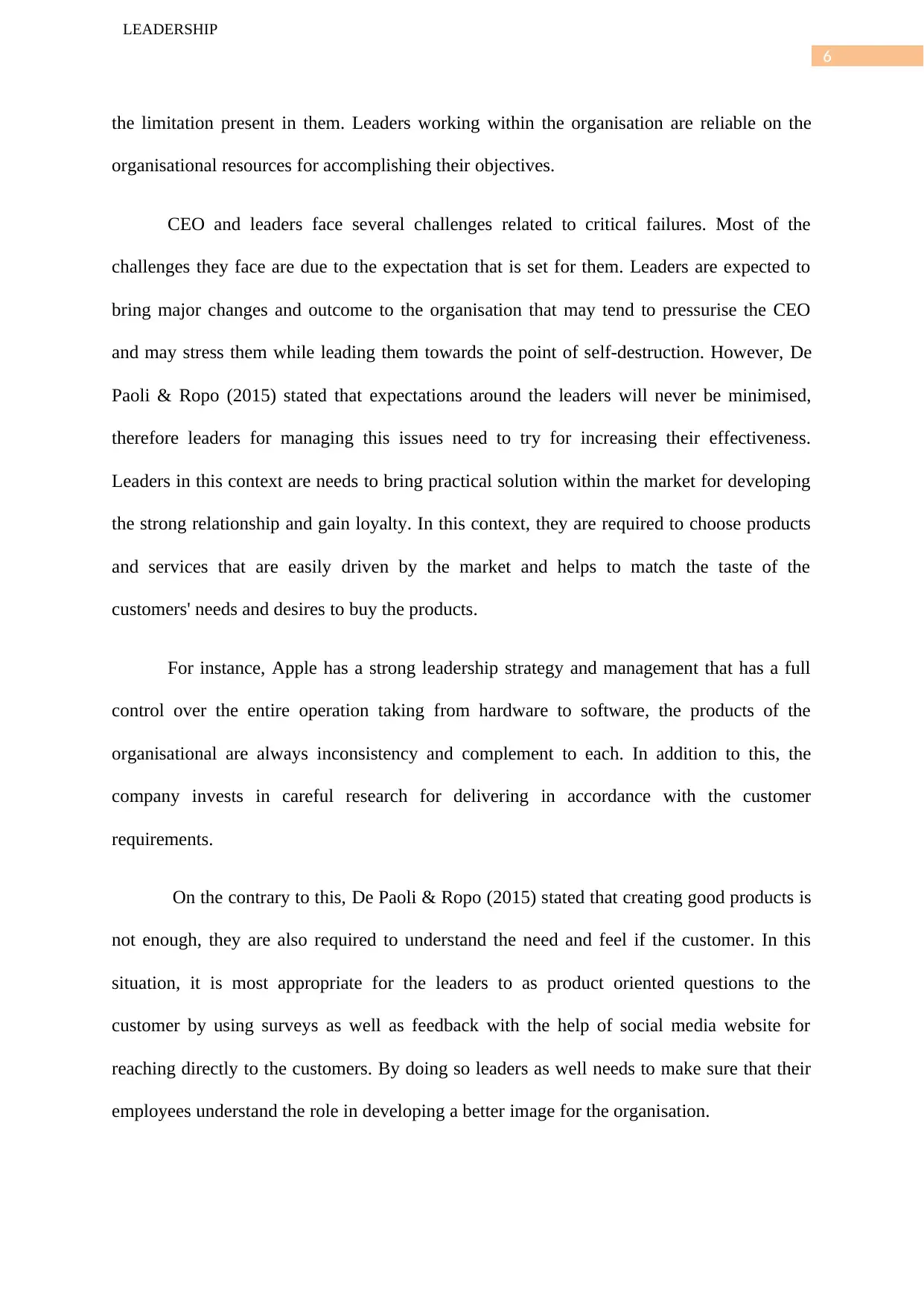
6
LEADERSHIP
the limitation present in them. Leaders working within the organisation are reliable on the
organisational resources for accomplishing their objectives.
CEO and leaders face several challenges related to critical failures. Most of the
challenges they face are due to the expectation that is set for them. Leaders are expected to
bring major changes and outcome to the organisation that may tend to pressurise the CEO
and may stress them while leading them towards the point of self-destruction. However, De
Paoli & Ropo (2015) stated that expectations around the leaders will never be minimised,
therefore leaders for managing this issues need to try for increasing their effectiveness.
Leaders in this context are needs to bring practical solution within the market for developing
the strong relationship and gain loyalty. In this context, they are required to choose products
and services that are easily driven by the market and helps to match the taste of the
customers' needs and desires to buy the products.
For instance, Apple has a strong leadership strategy and management that has a full
control over the entire operation taking from hardware to software, the products of the
organisational are always inconsistency and complement to each. In addition to this, the
company invests in careful research for delivering in accordance with the customer
requirements.
On the contrary to this, De Paoli & Ropo (2015) stated that creating good products is
not enough, they are also required to understand the need and feel if the customer. In this
situation, it is most appropriate for the leaders to as product oriented questions to the
customer by using surveys as well as feedback with the help of social media website for
reaching directly to the customers. By doing so leaders as well needs to make sure that their
employees understand the role in developing a better image for the organisation.
LEADERSHIP
the limitation present in them. Leaders working within the organisation are reliable on the
organisational resources for accomplishing their objectives.
CEO and leaders face several challenges related to critical failures. Most of the
challenges they face are due to the expectation that is set for them. Leaders are expected to
bring major changes and outcome to the organisation that may tend to pressurise the CEO
and may stress them while leading them towards the point of self-destruction. However, De
Paoli & Ropo (2015) stated that expectations around the leaders will never be minimised,
therefore leaders for managing this issues need to try for increasing their effectiveness.
Leaders in this context are needs to bring practical solution within the market for developing
the strong relationship and gain loyalty. In this context, they are required to choose products
and services that are easily driven by the market and helps to match the taste of the
customers' needs and desires to buy the products.
For instance, Apple has a strong leadership strategy and management that has a full
control over the entire operation taking from hardware to software, the products of the
organisational are always inconsistency and complement to each. In addition to this, the
company invests in careful research for delivering in accordance with the customer
requirements.
On the contrary to this, De Paoli & Ropo (2015) stated that creating good products is
not enough, they are also required to understand the need and feel if the customer. In this
situation, it is most appropriate for the leaders to as product oriented questions to the
customer by using surveys as well as feedback with the help of social media website for
reaching directly to the customers. By doing so leaders as well needs to make sure that their
employees understand the role in developing a better image for the organisation.
⊘ This is a preview!⊘
Do you want full access?
Subscribe today to unlock all pages.

Trusted by 1+ million students worldwide
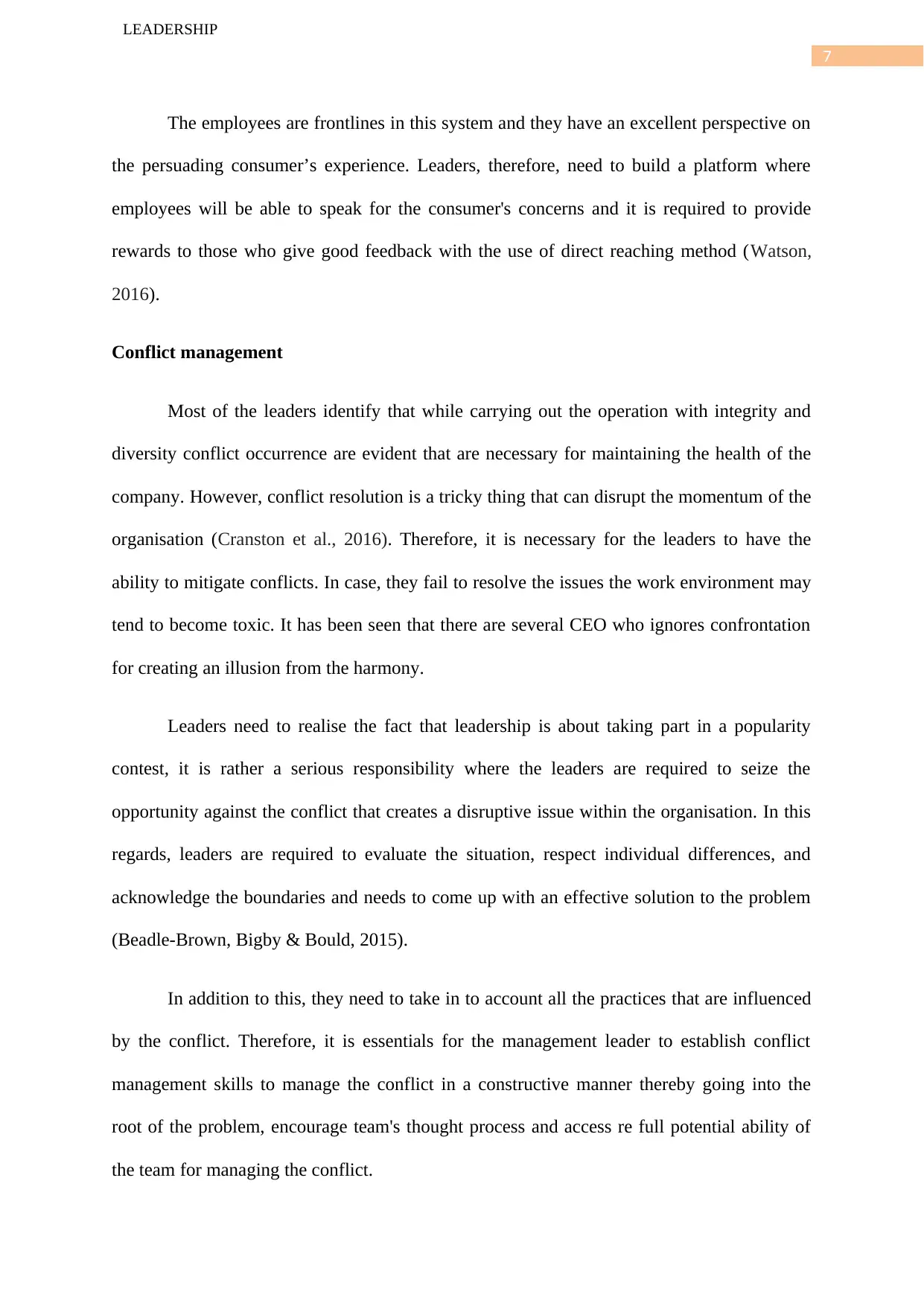
7
LEADERSHIP
The employees are frontlines in this system and they have an excellent perspective on
the persuading consumer’s experience. Leaders, therefore, need to build a platform where
employees will be able to speak for the consumer's concerns and it is required to provide
rewards to those who give good feedback with the use of direct reaching method (Watson,
2016).
Conflict management
Most of the leaders identify that while carrying out the operation with integrity and
diversity conflict occurrence are evident that are necessary for maintaining the health of the
company. However, conflict resolution is a tricky thing that can disrupt the momentum of the
organisation (Cranston et al., 2016). Therefore, it is necessary for the leaders to have the
ability to mitigate conflicts. In case, they fail to resolve the issues the work environment may
tend to become toxic. It has been seen that there are several CEO who ignores confrontation
for creating an illusion from the harmony.
Leaders need to realise the fact that leadership is about taking part in a popularity
contest, it is rather a serious responsibility where the leaders are required to seize the
opportunity against the conflict that creates a disruptive issue within the organisation. In this
regards, leaders are required to evaluate the situation, respect individual differences, and
acknowledge the boundaries and needs to come up with an effective solution to the problem
(Beadle‐Brown, Bigby & Bould, 2015).
In addition to this, they need to take in to account all the practices that are influenced
by the conflict. Therefore, it is essentials for the management leader to establish conflict
management skills to manage the conflict in a constructive manner thereby going into the
root of the problem, encourage team's thought process and access re full potential ability of
the team for managing the conflict.
LEADERSHIP
The employees are frontlines in this system and they have an excellent perspective on
the persuading consumer’s experience. Leaders, therefore, need to build a platform where
employees will be able to speak for the consumer's concerns and it is required to provide
rewards to those who give good feedback with the use of direct reaching method (Watson,
2016).
Conflict management
Most of the leaders identify that while carrying out the operation with integrity and
diversity conflict occurrence are evident that are necessary for maintaining the health of the
company. However, conflict resolution is a tricky thing that can disrupt the momentum of the
organisation (Cranston et al., 2016). Therefore, it is necessary for the leaders to have the
ability to mitigate conflicts. In case, they fail to resolve the issues the work environment may
tend to become toxic. It has been seen that there are several CEO who ignores confrontation
for creating an illusion from the harmony.
Leaders need to realise the fact that leadership is about taking part in a popularity
contest, it is rather a serious responsibility where the leaders are required to seize the
opportunity against the conflict that creates a disruptive issue within the organisation. In this
regards, leaders are required to evaluate the situation, respect individual differences, and
acknowledge the boundaries and needs to come up with an effective solution to the problem
(Beadle‐Brown, Bigby & Bould, 2015).
In addition to this, they need to take in to account all the practices that are influenced
by the conflict. Therefore, it is essentials for the management leader to establish conflict
management skills to manage the conflict in a constructive manner thereby going into the
root of the problem, encourage team's thought process and access re full potential ability of
the team for managing the conflict.
Paraphrase This Document
Need a fresh take? Get an instant paraphrase of this document with our AI Paraphraser
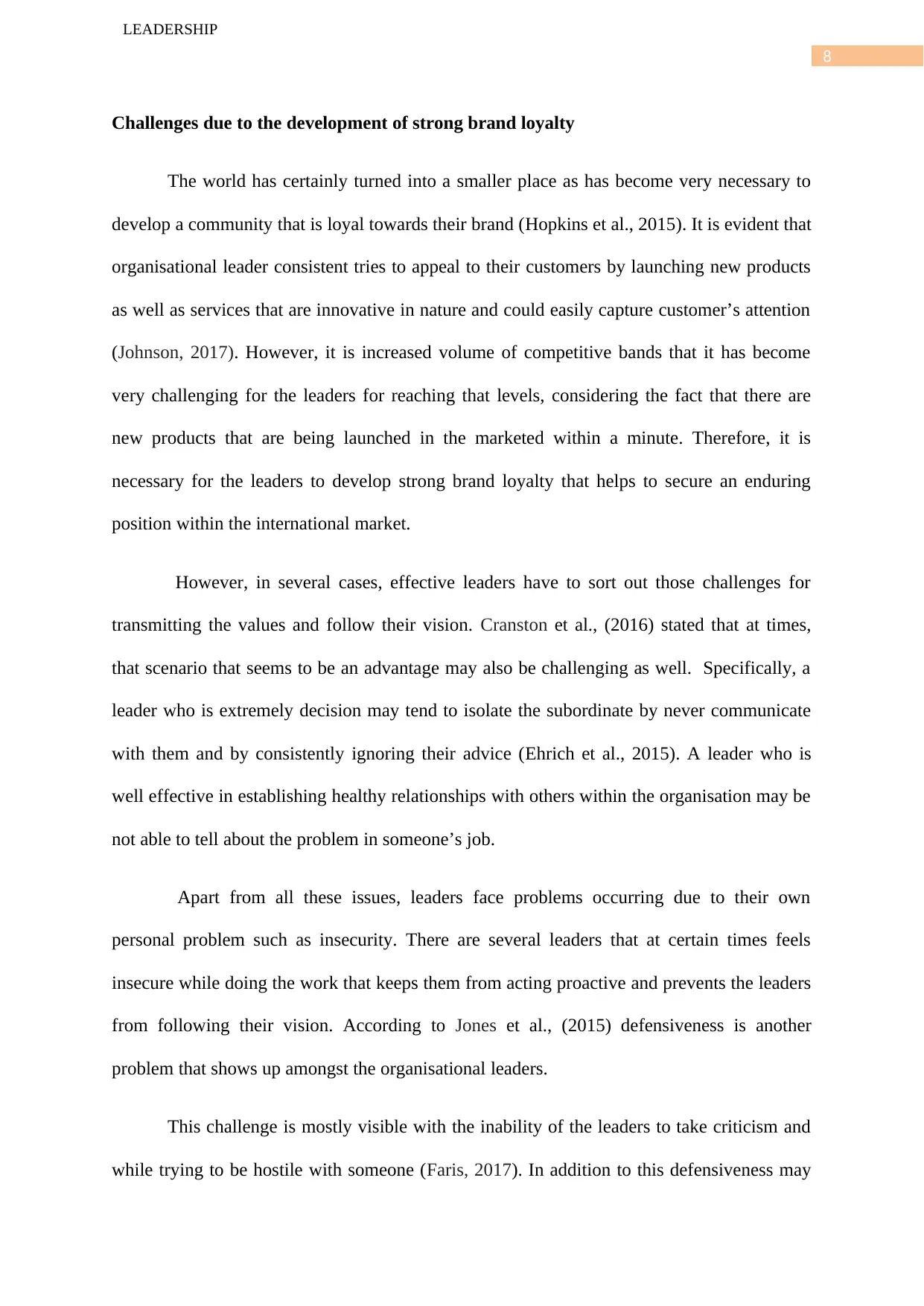
8
LEADERSHIP
Challenges due to the development of strong brand loyalty
The world has certainly turned into a smaller place as has become very necessary to
develop a community that is loyal towards their brand (Hopkins et al., 2015). It is evident that
organisational leader consistent tries to appeal to their customers by launching new products
as well as services that are innovative in nature and could easily capture customer’s attention
(Johnson, 2017). However, it is increased volume of competitive bands that it has become
very challenging for the leaders for reaching that levels, considering the fact that there are
new products that are being launched in the marketed within a minute. Therefore, it is
necessary for the leaders to develop strong brand loyalty that helps to secure an enduring
position within the international market.
However, in several cases, effective leaders have to sort out those challenges for
transmitting the values and follow their vision. Cranston et al., (2016) stated that at times,
that scenario that seems to be an advantage may also be challenging as well. Specifically, a
leader who is extremely decision may tend to isolate the subordinate by never communicate
with them and by consistently ignoring their advice (Ehrich et al., 2015). A leader who is
well effective in establishing healthy relationships with others within the organisation may be
not able to tell about the problem in someone’s job.
Apart from all these issues, leaders face problems occurring due to their own
personal problem such as insecurity. There are several leaders that at certain times feels
insecure while doing the work that keeps them from acting proactive and prevents the leaders
from following their vision. According to Jones et al., (2015) defensiveness is another
problem that shows up amongst the organisational leaders.
This challenge is mostly visible with the inability of the leaders to take criticism and
while trying to be hostile with someone (Faris, 2017). In addition to this defensiveness may
LEADERSHIP
Challenges due to the development of strong brand loyalty
The world has certainly turned into a smaller place as has become very necessary to
develop a community that is loyal towards their brand (Hopkins et al., 2015). It is evident that
organisational leader consistent tries to appeal to their customers by launching new products
as well as services that are innovative in nature and could easily capture customer’s attention
(Johnson, 2017). However, it is increased volume of competitive bands that it has become
very challenging for the leaders for reaching that levels, considering the fact that there are
new products that are being launched in the marketed within a minute. Therefore, it is
necessary for the leaders to develop strong brand loyalty that helps to secure an enduring
position within the international market.
However, in several cases, effective leaders have to sort out those challenges for
transmitting the values and follow their vision. Cranston et al., (2016) stated that at times,
that scenario that seems to be an advantage may also be challenging as well. Specifically, a
leader who is extremely decision may tend to isolate the subordinate by never communicate
with them and by consistently ignoring their advice (Ehrich et al., 2015). A leader who is
well effective in establishing healthy relationships with others within the organisation may be
not able to tell about the problem in someone’s job.
Apart from all these issues, leaders face problems occurring due to their own
personal problem such as insecurity. There are several leaders that at certain times feels
insecure while doing the work that keeps them from acting proactive and prevents the leaders
from following their vision. According to Jones et al., (2015) defensiveness is another
problem that shows up amongst the organisational leaders.
This challenge is mostly visible with the inability of the leaders to take criticism and
while trying to be hostile with someone (Faris, 2017). In addition to this defensiveness may
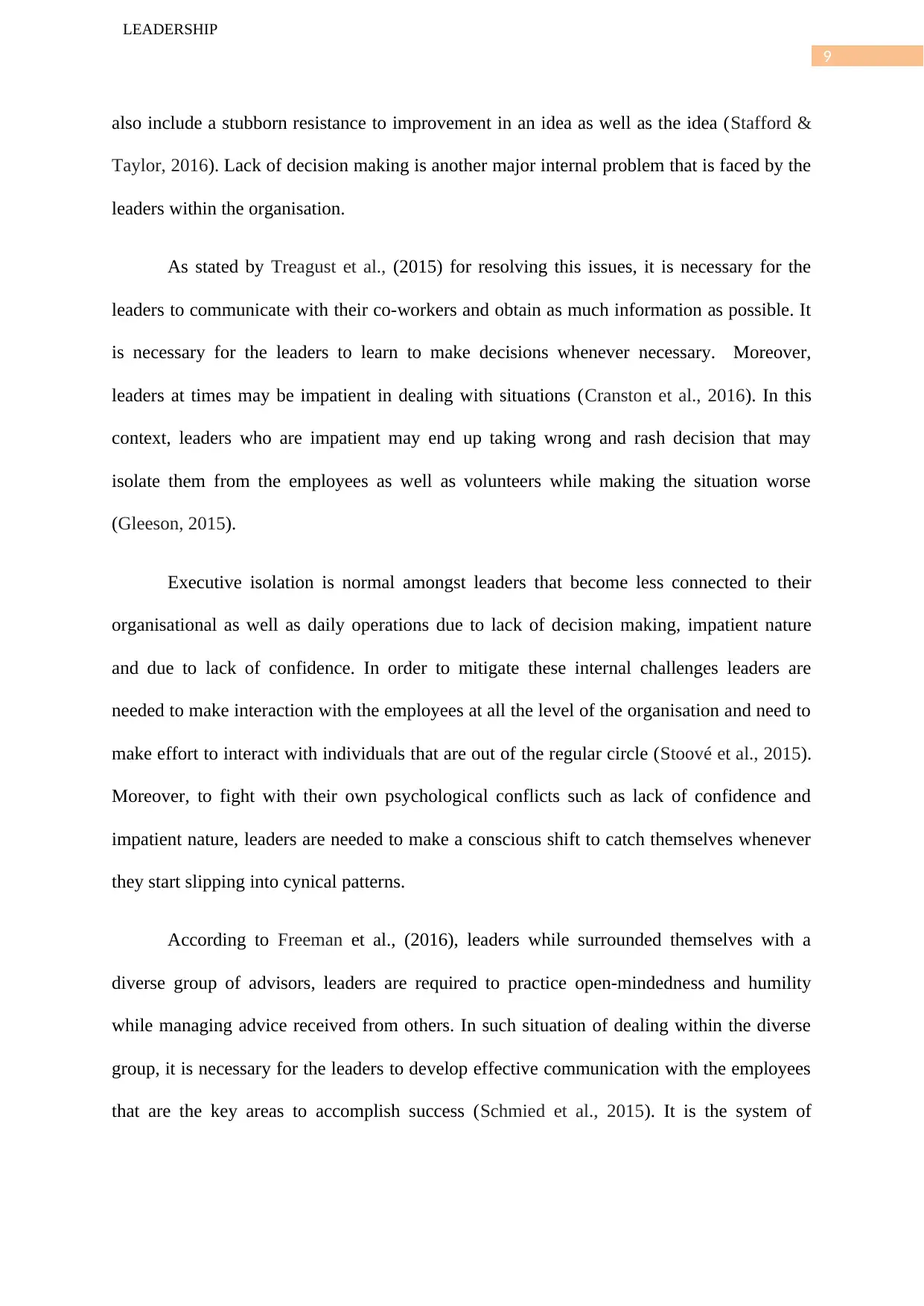
9
LEADERSHIP
also include a stubborn resistance to improvement in an idea as well as the idea (Stafford &
Taylor, 2016). Lack of decision making is another major internal problem that is faced by the
leaders within the organisation.
As stated by Treagust et al., (2015) for resolving this issues, it is necessary for the
leaders to communicate with their co-workers and obtain as much information as possible. It
is necessary for the leaders to learn to make decisions whenever necessary. Moreover,
leaders at times may be impatient in dealing with situations (Cranston et al., 2016). In this
context, leaders who are impatient may end up taking wrong and rash decision that may
isolate them from the employees as well as volunteers while making the situation worse
(Gleeson, 2015).
Executive isolation is normal amongst leaders that become less connected to their
organisational as well as daily operations due to lack of decision making, impatient nature
and due to lack of confidence. In order to mitigate these internal challenges leaders are
needed to make interaction with the employees at all the level of the organisation and need to
make effort to interact with individuals that are out of the regular circle (Stoové et al., 2015).
Moreover, to fight with their own psychological conflicts such as lack of confidence and
impatient nature, leaders are needed to make a conscious shift to catch themselves whenever
they start slipping into cynical patterns.
According to Freeman et al., (2016), leaders while surrounded themselves with a
diverse group of advisors, leaders are required to practice open-mindedness and humility
while managing advice received from others. In such situation of dealing within the diverse
group, it is necessary for the leaders to develop effective communication with the employees
that are the key areas to accomplish success (Schmied et al., 2015). It is the system of
LEADERSHIP
also include a stubborn resistance to improvement in an idea as well as the idea (Stafford &
Taylor, 2016). Lack of decision making is another major internal problem that is faced by the
leaders within the organisation.
As stated by Treagust et al., (2015) for resolving this issues, it is necessary for the
leaders to communicate with their co-workers and obtain as much information as possible. It
is necessary for the leaders to learn to make decisions whenever necessary. Moreover,
leaders at times may be impatient in dealing with situations (Cranston et al., 2016). In this
context, leaders who are impatient may end up taking wrong and rash decision that may
isolate them from the employees as well as volunteers while making the situation worse
(Gleeson, 2015).
Executive isolation is normal amongst leaders that become less connected to their
organisational as well as daily operations due to lack of decision making, impatient nature
and due to lack of confidence. In order to mitigate these internal challenges leaders are
needed to make interaction with the employees at all the level of the organisation and need to
make effort to interact with individuals that are out of the regular circle (Stoové et al., 2015).
Moreover, to fight with their own psychological conflicts such as lack of confidence and
impatient nature, leaders are needed to make a conscious shift to catch themselves whenever
they start slipping into cynical patterns.
According to Freeman et al., (2016), leaders while surrounded themselves with a
diverse group of advisors, leaders are required to practice open-mindedness and humility
while managing advice received from others. In such situation of dealing within the diverse
group, it is necessary for the leaders to develop effective communication with the employees
that are the key areas to accomplish success (Schmied et al., 2015). It is the system of
⊘ This is a preview!⊘
Do you want full access?
Subscribe today to unlock all pages.

Trusted by 1+ million students worldwide

10
LEADERSHIP
feedback that will help the employees to develop their skills and will also help to develop the
leader’s role in improving leadership development program.
Conclusion
Therefore, it is evident from the study above that challenges are emerging and evident
among organisational leaders. It has been seen that some leadership challenges are
predictable whereas some of the leadership challenges help to motivate the team and in
guiding organisational improvement mainly for prioritizing the right things at the appropriate
time. Leaders have been seen to face several challenges occurring due to isolation and lack of
connectivity of the leaders with the regular operation.
On the contrary, to this, some leaders are facing problem due to lack of decision
making, impatient nature and lack of defensiveness. The major external problem faced by the
leaders within the organisation in the threat from the growing technology. Technology is
snatching away all the potential power of the leaders by building connecting through social
media network and other agile services. The leaders can take advantage of the growing media
to fight with the growing challenges and can take action to improve the leadership
development programs.
For managing other issues such as indecisiveness, lack of cooperation leaders needs
to develop effective communication. In this context, it has been seen in the study that clarity
and consistency is the major way to develop effective communication. It is required for the
management leaders to be open and accessible while communicating with employees so that
they feel convertible in coming up with their problems. This will allow the leaders to avoid
being feel pressurised and micromanaging.
LEADERSHIP
feedback that will help the employees to develop their skills and will also help to develop the
leader’s role in improving leadership development program.
Conclusion
Therefore, it is evident from the study above that challenges are emerging and evident
among organisational leaders. It has been seen that some leadership challenges are
predictable whereas some of the leadership challenges help to motivate the team and in
guiding organisational improvement mainly for prioritizing the right things at the appropriate
time. Leaders have been seen to face several challenges occurring due to isolation and lack of
connectivity of the leaders with the regular operation.
On the contrary, to this, some leaders are facing problem due to lack of decision
making, impatient nature and lack of defensiveness. The major external problem faced by the
leaders within the organisation in the threat from the growing technology. Technology is
snatching away all the potential power of the leaders by building connecting through social
media network and other agile services. The leaders can take advantage of the growing media
to fight with the growing challenges and can take action to improve the leadership
development programs.
For managing other issues such as indecisiveness, lack of cooperation leaders needs
to develop effective communication. In this context, it has been seen in the study that clarity
and consistency is the major way to develop effective communication. It is required for the
management leaders to be open and accessible while communicating with employees so that
they feel convertible in coming up with their problems. This will allow the leaders to avoid
being feel pressurised and micromanaging.
Paraphrase This Document
Need a fresh take? Get an instant paraphrase of this document with our AI Paraphraser
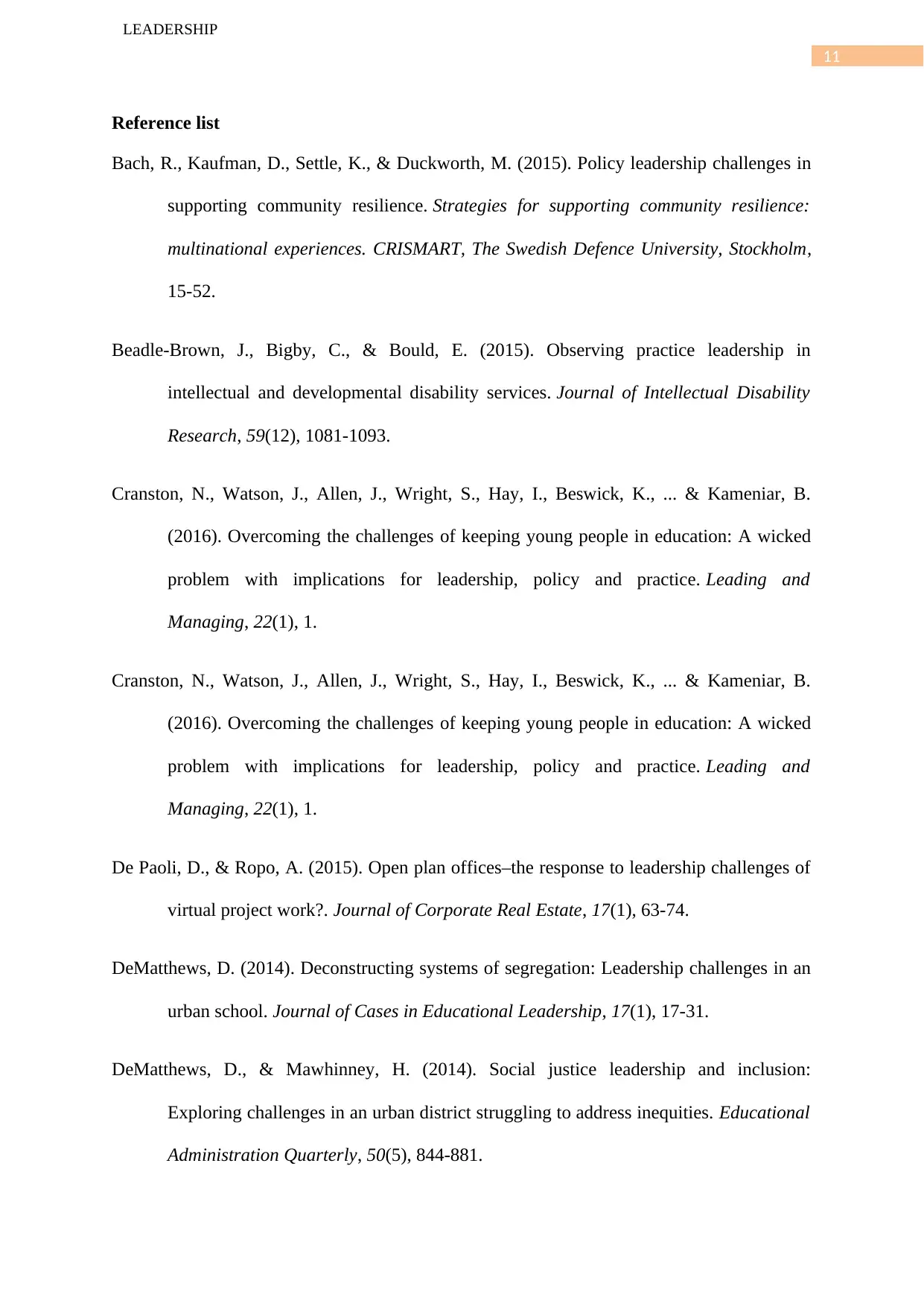
11
LEADERSHIP
Reference list
Bach, R., Kaufman, D., Settle, K., & Duckworth, M. (2015). Policy leadership challenges in
supporting community resilience. Strategies for supporting community resilience:
multinational experiences. CRISMART, The Swedish Defence University, Stockholm,
15-52.
Beadle‐Brown, J., Bigby, C., & Bould, E. (2015). Observing practice leadership in
intellectual and developmental disability services. Journal of Intellectual Disability
Research, 59(12), 1081-1093.
Cranston, N., Watson, J., Allen, J., Wright, S., Hay, I., Beswick, K., ... & Kameniar, B.
(2016). Overcoming the challenges of keeping young people in education: A wicked
problem with implications for leadership, policy and practice. Leading and
Managing, 22(1), 1.
Cranston, N., Watson, J., Allen, J., Wright, S., Hay, I., Beswick, K., ... & Kameniar, B.
(2016). Overcoming the challenges of keeping young people in education: A wicked
problem with implications for leadership, policy and practice. Leading and
Managing, 22(1), 1.
De Paoli, D., & Ropo, A. (2015). Open plan offices–the response to leadership challenges of
virtual project work?. Journal of Corporate Real Estate, 17(1), 63-74.
DeMatthews, D. (2014). Deconstructing systems of segregation: Leadership challenges in an
urban school. Journal of Cases in Educational Leadership, 17(1), 17-31.
DeMatthews, D., & Mawhinney, H. (2014). Social justice leadership and inclusion:
Exploring challenges in an urban district struggling to address inequities. Educational
Administration Quarterly, 50(5), 844-881.
LEADERSHIP
Reference list
Bach, R., Kaufman, D., Settle, K., & Duckworth, M. (2015). Policy leadership challenges in
supporting community resilience. Strategies for supporting community resilience:
multinational experiences. CRISMART, The Swedish Defence University, Stockholm,
15-52.
Beadle‐Brown, J., Bigby, C., & Bould, E. (2015). Observing practice leadership in
intellectual and developmental disability services. Journal of Intellectual Disability
Research, 59(12), 1081-1093.
Cranston, N., Watson, J., Allen, J., Wright, S., Hay, I., Beswick, K., ... & Kameniar, B.
(2016). Overcoming the challenges of keeping young people in education: A wicked
problem with implications for leadership, policy and practice. Leading and
Managing, 22(1), 1.
Cranston, N., Watson, J., Allen, J., Wright, S., Hay, I., Beswick, K., ... & Kameniar, B.
(2016). Overcoming the challenges of keeping young people in education: A wicked
problem with implications for leadership, policy and practice. Leading and
Managing, 22(1), 1.
De Paoli, D., & Ropo, A. (2015). Open plan offices–the response to leadership challenges of
virtual project work?. Journal of Corporate Real Estate, 17(1), 63-74.
DeMatthews, D. (2014). Deconstructing systems of segregation: Leadership challenges in an
urban school. Journal of Cases in Educational Leadership, 17(1), 17-31.
DeMatthews, D., & Mawhinney, H. (2014). Social justice leadership and inclusion:
Exploring challenges in an urban district struggling to address inequities. Educational
Administration Quarterly, 50(5), 844-881.
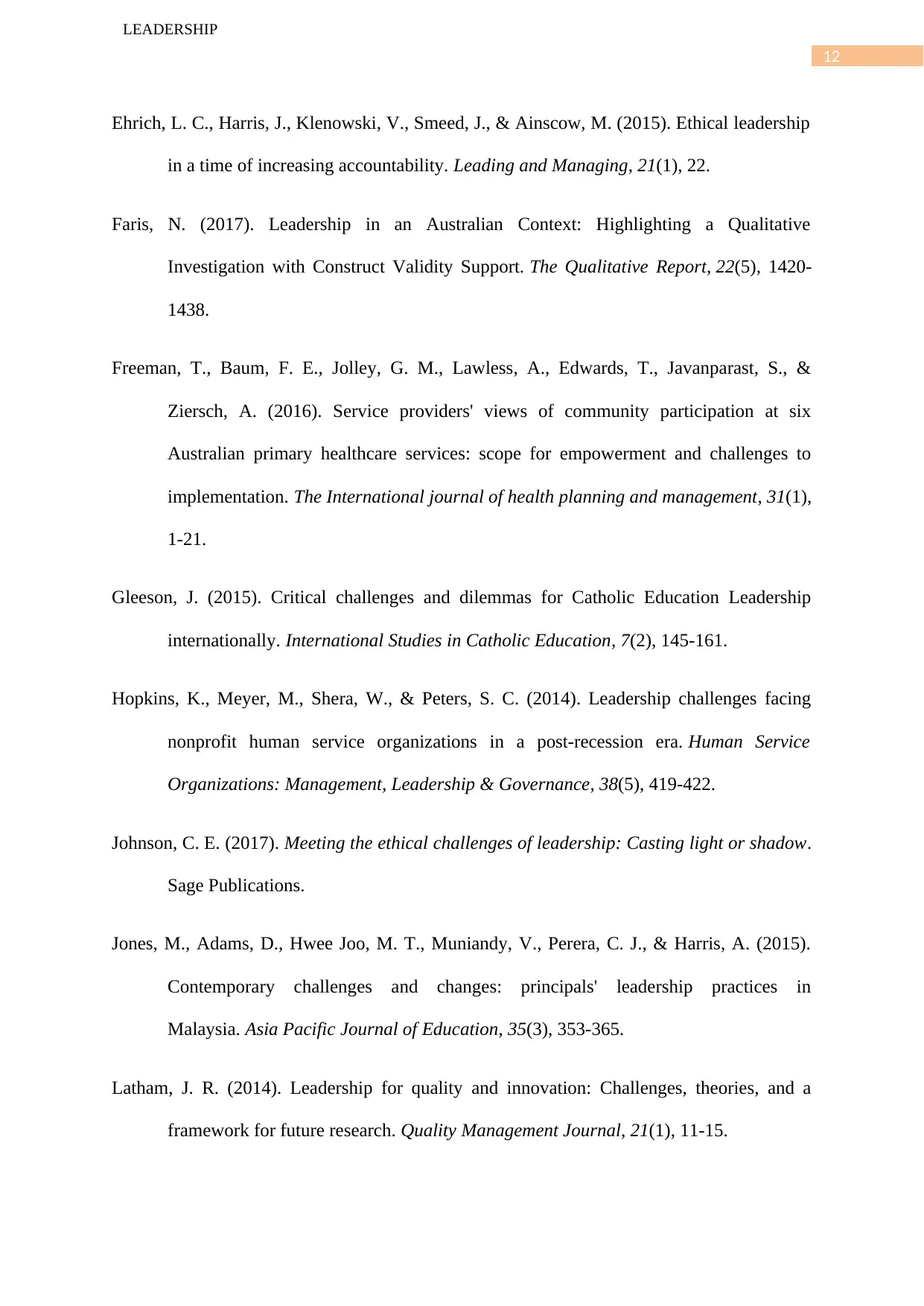
12
LEADERSHIP
Ehrich, L. C., Harris, J., Klenowski, V., Smeed, J., & Ainscow, M. (2015). Ethical leadership
in a time of increasing accountability. Leading and Managing, 21(1), 22.
Faris, N. (2017). Leadership in an Australian Context: Highlighting a Qualitative
Investigation with Construct Validity Support. The Qualitative Report, 22(5), 1420-
1438.
Freeman, T., Baum, F. E., Jolley, G. M., Lawless, A., Edwards, T., Javanparast, S., &
Ziersch, A. (2016). Service providers' views of community participation at six
Australian primary healthcare services: scope for empowerment and challenges to
implementation. The International journal of health planning and management, 31(1),
1-21.
Gleeson, J. (2015). Critical challenges and dilemmas for Catholic Education Leadership
internationally. International Studies in Catholic Education, 7(2), 145-161.
Hopkins, K., Meyer, M., Shera, W., & Peters, S. C. (2014). Leadership challenges facing
nonprofit human service organizations in a post-recession era. Human Service
Organizations: Management, Leadership & Governance, 38(5), 419-422.
Johnson, C. E. (2017). Meeting the ethical challenges of leadership: Casting light or shadow.
Sage Publications.
Jones, M., Adams, D., Hwee Joo, M. T., Muniandy, V., Perera, C. J., & Harris, A. (2015).
Contemporary challenges and changes: principals' leadership practices in
Malaysia. Asia Pacific Journal of Education, 35(3), 353-365.
Latham, J. R. (2014). Leadership for quality and innovation: Challenges, theories, and a
framework for future research. Quality Management Journal, 21(1), 11-15.
LEADERSHIP
Ehrich, L. C., Harris, J., Klenowski, V., Smeed, J., & Ainscow, M. (2015). Ethical leadership
in a time of increasing accountability. Leading and Managing, 21(1), 22.
Faris, N. (2017). Leadership in an Australian Context: Highlighting a Qualitative
Investigation with Construct Validity Support. The Qualitative Report, 22(5), 1420-
1438.
Freeman, T., Baum, F. E., Jolley, G. M., Lawless, A., Edwards, T., Javanparast, S., &
Ziersch, A. (2016). Service providers' views of community participation at six
Australian primary healthcare services: scope for empowerment and challenges to
implementation. The International journal of health planning and management, 31(1),
1-21.
Gleeson, J. (2015). Critical challenges and dilemmas for Catholic Education Leadership
internationally. International Studies in Catholic Education, 7(2), 145-161.
Hopkins, K., Meyer, M., Shera, W., & Peters, S. C. (2014). Leadership challenges facing
nonprofit human service organizations in a post-recession era. Human Service
Organizations: Management, Leadership & Governance, 38(5), 419-422.
Johnson, C. E. (2017). Meeting the ethical challenges of leadership: Casting light or shadow.
Sage Publications.
Jones, M., Adams, D., Hwee Joo, M. T., Muniandy, V., Perera, C. J., & Harris, A. (2015).
Contemporary challenges and changes: principals' leadership practices in
Malaysia. Asia Pacific Journal of Education, 35(3), 353-365.
Latham, J. R. (2014). Leadership for quality and innovation: Challenges, theories, and a
framework for future research. Quality Management Journal, 21(1), 11-15.
⊘ This is a preview!⊘
Do you want full access?
Subscribe today to unlock all pages.

Trusted by 1+ million students worldwide
1 out of 14
Related Documents
Your All-in-One AI-Powered Toolkit for Academic Success.
+13062052269
info@desklib.com
Available 24*7 on WhatsApp / Email
![[object Object]](/_next/static/media/star-bottom.7253800d.svg)
Unlock your academic potential
Copyright © 2020–2025 A2Z Services. All Rights Reserved. Developed and managed by ZUCOL.





